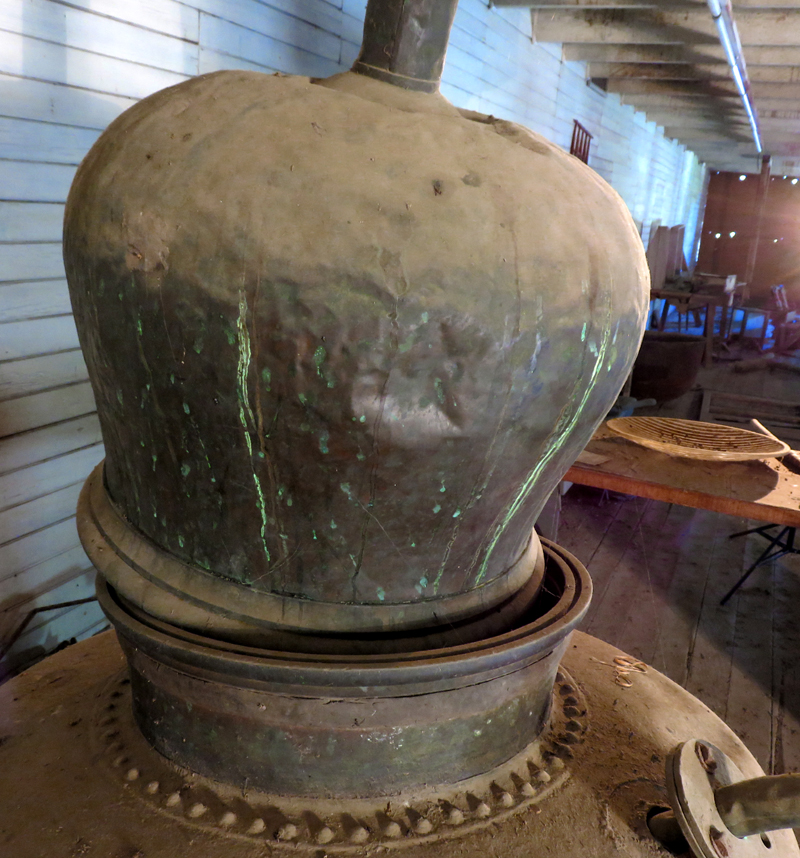|
|
Del Valle Winery | Rancho Camulos

Click image to enlarge
June 28, 2014 — Del Valle boiler for distilling brandy, in use approx. 1867-1900, located on the second floor of the Del Valle winery at Rancho Camulos. No maker's mark (at least, none visible on any of the exposed areas). Light source: Artificial.
August Rubel, who purchased Rancho Camulos from the Del Valle family in 1924, maintained a private museum in a second-floor section of the two-story 1867 Del Valle winery, where the Del Valles' brandy still was (and is) located. Rubel was 43 when he was killed in North Africa in 1943. After World War II the winery was essentially untouched except to be used for storage. The building was condemned ("red-tagged") after the 1994 Northridge earthquake and has sat derelict since that time. As of 2014, some of Rubel's museum displays are as he left them, caked under 75 years of dust and detritus. Some are in the process of being organized and conserved. If Rubel left written information about the artifacts or their origins, it hasn't been located. (After the 1994 earthquake, the restoration of the other buildings at Camulos took precedence — the original "Home of Ramona" adobe, the Del Valle chapel, the Rubel schoolhouse and the smaller adobe that's actively being turned into a visitors center. It's a process. Your tax-deductible cash donation to the 501c3 nonprofit Rancho Camulos Museum will be put to good use.) — Leon Worden 2014 Rancho Camulos was primarily a cattle ranch from 1842, when Ygnacio del Valle inherited the western section of the 48,000-acre Rancho San Francisco and stocked it with cattle, until 1857, when Ygnacio bought the adjacent 13,339-acre Rancho Temescal to the north (Piru area), moved the cattle there, and planted the Santa Clara River Valley's first commercial orange grove on the former cattle range. Other siblings inherited the rest of the Rancho San Francisco. After the family lost it to foreclosure ... here's the short story. Back then (as now), ranchers borrowed the money they needed each year to raise their stock. Then, when they brought their beef to market, they'd repay the loans. Well, the drought of 1863-64 that followed the torrential rains of 1861-62 killed the Del Valles' stock, so they couldn't pay back the loans. The bankers foreclosed — but Ygnacio, a big-league L.A. politician, worked a deal to keep the 1,500-acre Camulos section. While all of this was happening, Ygnacio and his son Juventino, the ranch manager, planted 90 acres of wine grapes and obtained a license to distill brandy. In 1867 they built a 1½-story brick winery near the 1853 adobe home, which basement had been used for wine storage. By 1870 the Del Valles were operating the biggest of four commercial wineries in the greater Ventura area (San Buenaventura Township). "It was the wine grape that brought the first real commercial success for the Del Valle family. Camulos wines and brandies enjoyed a good reputation throughout Los Angeles and Santa Barbara" (Triem & Stone, Rancho Camulos: National Register of Historic Places Nomination, 1996). They also planted almonds, wheat, corn and barley. Triem & Stone cite an 1891 source that reported: "The rancho is divided about equally into farming and grazing land. The pastures raise horses, horned cattle, sheep and hogs. ... Here are grown excellent crops of wheat, in quality very superior, also bountiful crops of barley, rye, oats, corn, potatoes, sweet potatoes, pumpkins, melons and all kinds of vegetables. ... The vineyard here is of 50,000 vines, which for many years have yielded 10,000 to 20,000 gallons of wine per year. From an orange grove of 2,000 trees, 1,200 boxes of fruit were shipped last season. The returns are handsome from 500 walnut trees, as also from the oil and pickled olives from a fine grove of 1,000 olive trees. Almost every kind of fruit grown in the United States is raised here." By 1900, citrus was emerging as the king. From 1908 to 1917, then-manager Ulpaino del Valle planted Valencia oranges as well as apricots and walnuts on former grazing land. By the time August Rubel bought the property in 1924 — Camulos has been owned by just two families since the end of war for Mexican independence from Spain — the grapes and almonds were gone, and the Rubels eventually replaced the walnuts and apricots with more oranges. According to Triem & Stone, as of 1996, six hundred acres were under cultivation as follows: 500 acres of Valencia oranges, 40 acres of lemons, 30 acres of grapefruit, 20 acres of navel oranges, and 10 acres of avocados. As for the 1867 winery, it became a storage room, and then the Rubels turned the upstairs into a Ramona museum (check the Camulos section on SCVHistory.com for that story), complete with Del Valle family artifacts. The building has been red-tagged (uninhabitable) since the 1994 Northridge earthquake.
LW2633h: 19200 dpi jpeg from digital image by Leon Worden. |
The site owner makes no assertions as to ownership of any original copyrights to digitized images. However, these images are intended for Personal or Research use only. Any other kind of use, including but not limited to commercial or scholarly publication in any medium or format, public exhibition, or use online or in a web site, may be subject to additional restrictions including but not limited to the copyrights held by parties other than the site owner. USERS ARE SOLELY RESPONSIBLE for determining the existence of such rights and for obtaining any permissions and/or paying associated fees necessary for the proposed use.

















